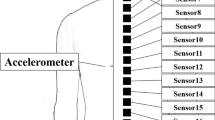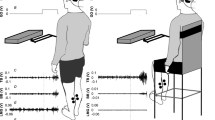Abstract
Neck muscle vibration (NMV) during upright standing is known to induce forward leaning, which has been explained as a global response to the (illusory) perception of a lengthening of the dorsal neck muscles. However, the effects of NMV both at the level of individual joints and on whole-body postural coordination, and its potential modulation by vision, have not yet been analyzed in detail. Eight healthy young adult participants completed a total of ten trials each, with a 10-s period of unperturbed standing followed by a 10-s period of NMV. Participants were instructed to stand “as still as possible”. This postural task was executed under two visual conditions: eyes open (EO) and eyes closed (EC). Postural responses were measured in terms of center of pressure (CoP) and center of mass (CoM) profiles, and whole-body kinematics. Responses to NMV at the level of individual body segments and joints were assessed by decomposing the time series into linear trends and residual fluctuations. Inter-segmental coordination was analyzed using a decorrelation technique, assessing motor-equivalent stabilization of four task-related variables: CoM position, trunk orientation, as well as head position and orientation. NMV induced a general forward leaning response under both visual conditions, visible in CoP, CoM, segment positions and orientations. Locally, NMV induced a pronounced extension of the atlanto-occipital joint. Residual fluctuations were higher with EC and unaffected by NMV. Coordination analysis showed that stabilization of different body parts was differentially affected by NMV. Head orientation was consistently stabilized across all conditions, with weaker coordination in the EC condition. In contrast, motor-equivalent stabilization of CoM and head position, and trunk orientation was only observed during no-vibration periods. Taken together, our results demonstrate specific effects of vision and proprioception on different aspects of local and global postural control. While perturbed neck proprioception seemed to affect the postural “set point” (inducing forward leaning), vision appeared to mainly serve in noise reduction (residual fluctuations) and control of head orientation.






Similar content being viewed by others
References
Bove M, Fenoggio C, Tacchino A, Pelosin E, Schieppati M (2009) Interaction between vision and neck proprioception in the control of stance. Neuroscience 164(4):1601–1608. doi:10.1016/j.neuroscience.2009.09.053
Cohen LA (1961) Role of eye and neck proprioceptive mechanisms in body orientation and motor coordination. J Neurophysiol 24:1–11
Cohen J (1988) Statistical power analysis for the behavioral sciences, 2nd edn. Lawrence Earlbaum Associates, Hillsdale
Creath R, Kiemel T, Horak F, Peterka R, Jeka J (2005) A unified view of quiet and perturbed stance: simultaneous co-existing excitable modes. Neurosci Lett 377(2):75–80. doi:10.1016/j.neulet.2004.11.071
Cusumano J, Cesari P (2006) Body-goal variability mapping in an aiming task. Biol Cybern 94:367–379
Eklund G (1971) On muscle vibration in man; an amplitude-dependent inhibition, inversely related to muscle length. Acta Physiol Scand 83(3):425–426
Eklund G (1972) General features of vibration-induced effects on balance. Ups J Med Sci 77(2):112–124
Eklund G, Hagbarth KE (1966) Normal variability of tonic vibration reflexes in man. Exp Neurol 16(1):80–92
Gilhodes JC, Roll JP, Tardy-Gervet MF (1986) Perceptual and motor effects of agonist–antagonist muscle vibration in man. Exp Brain Res 61(2):395–402
Gomez S, Patel M, Magnusson M, Johansson L, Einarsson EJ, Fransson PA (2009) Differences between body movement adaptation to calf and neck muscle vibratory proprioceptive stimulation. Gait Posture 30(1):93–99. doi:10.1016/j.gaitpost.2009.03.009
Goodwin GM, McCloskey DI, Matthews PB (1972a) The contribution of muscle afferents to kinaesthesia shown by vibration induced illusions of movement and by the effects of paralysing joint afferents. Brain 95(4):705–748
Goodwin GM, McCloskey DI, Matthews PB (1972b) Proprioceptive illusions induced by muscle vibration: contribution by muscle spindles to perception? Science 175(28):1382–1384
Gregoric M, Takeya T, Baron JB, Bessineton JC (1978) Influence of vibration of neck muscles on balance control in man. Agressologie 19(A):37–38
Gurfinkel VS, YuP I, YuS L, Babakova IA (1995) Kinesthetic reference for human orthograde posture. Neuroscience 68(1):229–243
Horak FB, MacPherson JM (1996) Postural orientation and equilibrium. In: Rowell L, Shepherd J (eds) Handbook of physiology. American Physiological Society, New York, pp 255–292
Hsu WL, Scholz JP, Schöner G, Jeka JJ, Kiemel T (2007) Control and estimation of posture during quiet stance depends on multijoint coordination. J Neurophysiol 97:3024–3035
Ivanenko YP, Talis VL, Kazennikov OV (1999) Support stability influences postural responses to muscle vibration in humans. Eur J Neurosci 11(2):647–654
Kavounoudias A, Gilhodes JC, Roll R, Roll JP (1999) From balance regulation to body orientation: two goals for muscle proprioceptive information processing? Exp Brain Res 124(1):80–88
Lackner JR, Levine MS (1979) Changes in apparent body orientation and sensory localization induced by vibration of postural muscles: vibratory myesthetic illusions. Aviat Space Environ Med 50(4):346–354
Latash ML, Scholz JP, Schöner G (2007) Toward a new theory of motor synergies. Mot Control 11:276–308
Lekhel H, Popov K, Anastasopoulos D, Bronstein A, Bhatia K, Marsden CD, Gresty M (1997) Postural responses to vibration of neck muscles in patients with idiopathic torticollis. Brain 120(4):583–591
Lekhel H, Popov K, Bronstein A, Gresty M (1998) Postural responses to vibration of neck muscles in patients with uni- and bilateral vestibular loss. Gait Posture 7(3):228–236
Lund S (1980) Postural effects of neck muscle vibration in man. Experientia 36(12):1398
Massion J (1994) Postural control system. Curr Opin Neurobiol 4(6):877–887
Mergner T, Huber W, Becker W (1997) Vestibular–neck interaction and transformation of sensory coordinates. J Vestib Res 7(4):347–367
Müller H, Sternad D (2003) A randomization method for the calculation of covariation in multiple nonlinear relations: illustrated with the example of goal-directed movements. Biol Cybern 89(1):22–33
Paulus WM, Straube A, Brandt T (1984) Visual stabilization of posture. physiological stimulus characteristics and clinical aspects. Brain 107(4):1143–1163
Peterka RJ (2002) Sensorimotor integration in human postural control. J Neurophysiol 88(3):1097–1118
Pinter IJ, van Swigchem R, van Soest AJK, Rozendaal LA (2008) The dynamics of postural sway cannot be captured using a one-segment inverted pendulum model: a PCA on segment rotations during unperturbed stance. J Neurophysiol 100(6):3197–3208. doi:10.1152/jn.01312.2007
R Development Core Team (2008) R: a language and environment for statistical computing. R Foundation for Statistical Computing, Vienna, Austria, http://www.R-project.org, ISBN 3-900051-07-0
Redfern MS, Yardley L, Bronstein AM (2001) Visual influences on balance. J Anxiety Disord 15(1–2):81–94
Roll J, Roll R (1988) From eye to foot: a proprioceptive chain involved in postural control. In: Amblard B, Berthoz A, Clarac F (eds) Posture and gait. Elsevier, Amsterdam, pp 155–164
Scholz JP, Schöner G (1999) The uncontrolled manifold concept: identifying control variables for a functional task. Exp Brain Res 126(3):289–306
Schöner G (1995) Recent developments and problems in human movement science and their conceptual implications. Ecol Psych 7(4):291–314
Vuillerme N, Burdet C, Isableu B, Demetz S (2006) The magnitude of the effect of calf muscles fatigue on postural control during bipedal quiet standing with vision depends on the eye–visual target distance. Gait Posture 24(2):169–172. doi:10.1016/j.gaitpost.2005.07.011
Winter DA (2004) Biomechanics and control of human movement. 3rd edition. John Wiley & Sons, Hoboken
Zhang Y, Kiemel T, Jeka J (2007) The influence of sensory information on two-component coordination during quiet stance. Gait Posture 26(2):263–271. doi:10.1016/j.gaitpost.2006.09.007
Zok M, Mazzà C, Cappozzo A (2008) Should the instructions issued to the subject in traditional static posturography be standardised? Med Eng Phys 30(7):913–916. doi:10.1016/j.medengphy.2007.12.002
Acknowledgments
During his dissertation, the first author was a pre-doctoral fellow of the International Max Planck Research School “The Life Course: Evolutionary and Ontogenetic Dynamic”. The study has been supported by a grant from the Centre de La Recherche Scientifique (CNRS, France) to the last author.
Author information
Authors and Affiliations
Corresponding authors
Rights and permissions
About this article
Cite this article
Verrel, J., Cuisinier, R., Lindenberger, U. et al. Local and global effects of neck muscle vibration during stabilization of upright standing. Exp Brain Res 210, 313–324 (2011). https://doi.org/10.1007/s00221-011-2636-9
Received:
Accepted:
Published:
Issue Date:
DOI: https://doi.org/10.1007/s00221-011-2636-9




